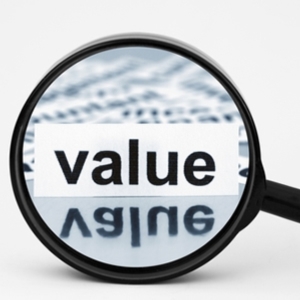 Several of my current clients are startup companies that understand that, to have real value, their patents must be seen by a third party as meaningful to the opportunity--be it customers, revenue stream, or any other business strategy--that this potential potential partner, licensor, or acquirer seeks to access. Put another way, patents generated by early stage companies that are developing innovative technology must “make it cheaper to go through them than around them.” For these types of patent owners, due diligence conducted by third parties is more than just “kicking the tires” of the patent portfolio; instead, their patents will be examined by an expert team to make sure they won’t "break" just when they’re needed most.
As an initial aspect of this discussion, it should be stressed that not all patents are equal in value. Some patents--and, in my view, this is the
Several of my current clients are startup companies that understand that, to have real value, their patents must be seen by a third party as meaningful to the opportunity--be it customers, revenue stream, or any other business strategy--that this potential potential partner, licensor, or acquirer seeks to access. Put another way, patents generated by early stage companies that are developing innovative technology must “make it cheaper to go through them than around them.” For these types of patent owners, due diligence conducted by third parties is more than just “kicking the tires” of the patent portfolio; instead, their patents will be examined by an expert team to make sure they won’t "break" just when they’re needed most.
As an initial aspect of this discussion, it should be stressed that not all patents are equal in value. Some patents--and, in my view, this is the
Startup Patent Strategy: Be Unbreakable
Patentability Reviews for Innovations
 Patent professionals can do a better job providing patentability review, or "opinion," services for innovators. As most readers would recognize, a patentability review assesses whether the invention to be claimed will meet the legal requirements for patentability. In the US, this entails an assessment by a patent attorney, which can be based on a formal or informal search, whether the client’s invention is novel and non-obvious over the prior art. The rules by which a patent attorney makes a determination of patentability are well-established and would not be considered controversial by most experienced practitioners. Nonetheless, as an IP Strategist who works exclusively with clients engaged in developing and delivering meaningful innovations to consumers, I know that these entrenched patentability assessment practices deserve retooling for those clients who can be classified as "innovators." To this end, I believe that the way the patent
Patent professionals can do a better job providing patentability review, or "opinion," services for innovators. As most readers would recognize, a patentability review assesses whether the invention to be claimed will meet the legal requirements for patentability. In the US, this entails an assessment by a patent attorney, which can be based on a formal or informal search, whether the client’s invention is novel and non-obvious over the prior art. The rules by which a patent attorney makes a determination of patentability are well-established and would not be considered controversial by most experienced practitioners. Nonetheless, as an IP Strategist who works exclusively with clients engaged in developing and delivering meaningful innovations to consumers, I know that these entrenched patentability assessment practices deserve retooling for those clients who can be classified as "innovators." To this end, I believe that the way the patent
Startup Patent Licensing: Beating the Long Odds
 Achieving meaningful revenue through licensing by startup entrepreneurs can be for all intents and purposes a “unicorn event:” much discussed, but rarely achieved. Notwithstanding this reality, a significant number of startup entrepreneurs who seek to engage me for IP Strategy and patent development consulting assert confidently that their necessity for a patent is based on a business strategy of licensing (or selling) their protected product or technology to an established company.
This is not surprising because it is embedded in the DNA of much of society that “if you build a better mousetrap, the world will beat a path to your door.” Late night infomercials featuring famous people and entrepreneur “hero stories” in the press also bolster this conviction. It is certainly heartwarming and inspiring to believe that an "Average Josephine" can become rich solely on
Achieving meaningful revenue through licensing by startup entrepreneurs can be for all intents and purposes a “unicorn event:” much discussed, but rarely achieved. Notwithstanding this reality, a significant number of startup entrepreneurs who seek to engage me for IP Strategy and patent development consulting assert confidently that their necessity for a patent is based on a business strategy of licensing (or selling) their protected product or technology to an established company.
This is not surprising because it is embedded in the DNA of much of society that “if you build a better mousetrap, the world will beat a path to your door.” Late night infomercials featuring famous people and entrepreneur “hero stories” in the press also bolster this conviction. It is certainly heartwarming and inspiring to believe that an "Average Josephine" can become rich solely on
Startup Patent Strategy: US Patent Non-Publication

Need Broad Patents Fast? Try This.
 That title got your attention, didn’t it? It was meant to. After another successful round of patent application examinations for several clients in the last year, I thought others would like access to my proven patent acquisition methodology. Certainly, there’s a lot more than I can include in this post, and what is presented here should be considered to be only a high level introduction to my process. Moreover, every client requires focused attention to generate the desired patent protection, and not every business scenario mandates this comprehensive approach. But, for those situations where company leadership determines that strong patent protection is a key to achieving the desired business outcomes from investment in innovative products and technology, this methodology is not only recommended, it is required for success. Put simply, if you do the hard work
That title got your attention, didn’t it? It was meant to. After another successful round of patent application examinations for several clients in the last year, I thought others would like access to my proven patent acquisition methodology. Certainly, there’s a lot more than I can include in this post, and what is presented here should be considered to be only a high level introduction to my process. Moreover, every client requires focused attention to generate the desired patent protection, and not every business scenario mandates this comprehensive approach. But, for those situations where company leadership determines that strong patent protection is a key to achieving the desired business outcomes from investment in innovative products and technology, this methodology is not only recommended, it is required for success. Put simply, if you do the hard work
Value-Enhancing Patent Prosecution Strategies (Part 1 of 4)
 In my role as the IP Strategist for a number of companies that do not employ in-house patent counsel, I am charged with making sure that my clients’ patenting efforts are in tune with their desired business outcomes. This means that instead of focusing on the drafting and prosecuting of patent applications that form the basis of most patent attorneys’ practices, I work at the front end of the patenting process to design patent strategies that will enhance my clients’ business value first and foremost. When alignment is created with business goals, subsequent patenting efforts will necessarily result in protection that matters to the value of the company. In this regard, I have a number of tools in my “Patent Strategy Toolbox” that I deploy regularly when developing patent prosecution recommendations. Notably, when I mention these tools to new clients,
In my role as the IP Strategist for a number of companies that do not employ in-house patent counsel, I am charged with making sure that my clients’ patenting efforts are in tune with their desired business outcomes. This means that instead of focusing on the drafting and prosecuting of patent applications that form the basis of most patent attorneys’ practices, I work at the front end of the patenting process to design patent strategies that will enhance my clients’ business value first and foremost. When alignment is created with business goals, subsequent patenting efforts will necessarily result in protection that matters to the value of the company. In this regard, I have a number of tools in my “Patent Strategy Toolbox” that I deploy regularly when developing patent prosecution recommendations. Notably, when I mention these tools to new clients,
IP Strategy is Increasing Focus at Innovative Companies: Here’s Why
 After more than 8 years, I can report that IP Strategy is an increasing focus at innovative companies, and there is a solid reason why this is so. By way of background, for many years, I have been part of a small minority of IP experts who advocate that companies desiring to maximize the value of their IP investments re-think the way they seek and obtain patents. In short, I and my IP Strategist peers urge companies to wrest control of their “IP destiny” from their legal service providers who have traditionally been seen as the primary drivers of the patenting process for their clients. Of course, readers of my regular ruminations know that my strongly held view is that “the
After more than 8 years, I can report that IP Strategy is an increasing focus at innovative companies, and there is a solid reason why this is so. By way of background, for many years, I have been part of a small minority of IP experts who advocate that companies desiring to maximize the value of their IP investments re-think the way they seek and obtain patents. In short, I and my IP Strategist peers urge companies to wrest control of their “IP destiny” from their legal service providers who have traditionally been seen as the primary drivers of the patenting process for their clients. Of course, readers of my regular ruminations know that my strongly held view is that “the
Companies Create Risk by Leaving IP Strategy Out of Innovation
 I recently had to give bad news to a new client, the CEO of a successful global electronic hardware company. This CEO hired me earlier this year to help ensure that his company's upcoming innovations, which were the product of a several year turnaround program, were protected from competitive knock-offs. I have completed a couple of projects for the company to date, and he now wanted to discuss IP protection for a new product for the European market that would serve as a platform for later product spin-offs both there and in the US. This new product incorporated a number of highly innovative features and almost certainly could generate broad patent protection. Unfortunately, however, I had to inform my client that his company's important innovation could not be patented in Europe because the product launch date occurred several months ago.
While
I recently had to give bad news to a new client, the CEO of a successful global electronic hardware company. This CEO hired me earlier this year to help ensure that his company's upcoming innovations, which were the product of a several year turnaround program, were protected from competitive knock-offs. I have completed a couple of projects for the company to date, and he now wanted to discuss IP protection for a new product for the European market that would serve as a platform for later product spin-offs both there and in the US. This new product incorporated a number of highly innovative features and almost certainly could generate broad patent protection. Unfortunately, however, I had to inform my client that his company's important innovation could not be patented in Europe because the product launch date occurred several months ago.
While
Lack of Focus on IP Strategy Destroys $100 Millions in Value
 As an IP Strategist, I am fascinated by stories from which declining business fortunes can be traced directly to failed patent strategies. Often, the failures can be traced to patent attorney errors that limit the effectiveness of a company's patent to prevent competitive knock-offs, but, often, the problems can be traced to the lack of accountability for IP strategy within an organization. For those companies where IP is a primary driver of competitive advantage, the absence of someone who "owns" the job of making sure IP is properly captured and protected can result in unrecoverable errors that opens the innovator to unwelcome competition. In this regard, the recent loss of patent protection to a popular drug product should serve as a useful case study on why the C-suites of innovative companies should consider strategic in-house IP counseling to be a
As an IP Strategist, I am fascinated by stories from which declining business fortunes can be traced directly to failed patent strategies. Often, the failures can be traced to patent attorney errors that limit the effectiveness of a company's patent to prevent competitive knock-offs, but, often, the problems can be traced to the lack of accountability for IP strategy within an organization. For those companies where IP is a primary driver of competitive advantage, the absence of someone who "owns" the job of making sure IP is properly captured and protected can result in unrecoverable errors that opens the innovator to unwelcome competition. In this regard, the recent loss of patent protection to a popular drug product should serve as a useful case study on why the C-suites of innovative companies should consider strategic in-house IP counseling to be a
Failure to Generate REAL Patent Protection: Keurig’s Story (Part 2)
 In Part 1 of this "Failure to Create REAL Patent Value: Keurig's Story," I asserted that the company's current business woes can be directly attributable to a flawed patent strategy. To summarize, as a result of the Keurig Green Mountain's failure to obtain durable patent rights on its coffee pods, there has been a proliferation of lower cost generic pods. Because these generic pods sell for about 40% less than the branded "K-Cup" pods, Keurig Green Mountain has and will continue to lose substantial revenue due to this increased competition, even while its coffee maker innovation remains wildly popular with consumers. The question then becomes how did the company fail to fully capitalize on the value its disruptive innovation created in the marketplace?
One can see what went wrong with Keurig Green Mountain's patent strategy by starting with the litigation record in which
In Part 1 of this "Failure to Create REAL Patent Value: Keurig's Story," I asserted that the company's current business woes can be directly attributable to a flawed patent strategy. To summarize, as a result of the Keurig Green Mountain's failure to obtain durable patent rights on its coffee pods, there has been a proliferation of lower cost generic pods. Because these generic pods sell for about 40% less than the branded "K-Cup" pods, Keurig Green Mountain has and will continue to lose substantial revenue due to this increased competition, even while its coffee maker innovation remains wildly popular with consumers. The question then becomes how did the company fail to fully capitalize on the value its disruptive innovation created in the marketplace?
One can see what went wrong with Keurig Green Mountain's patent strategy by starting with the litigation record in which


